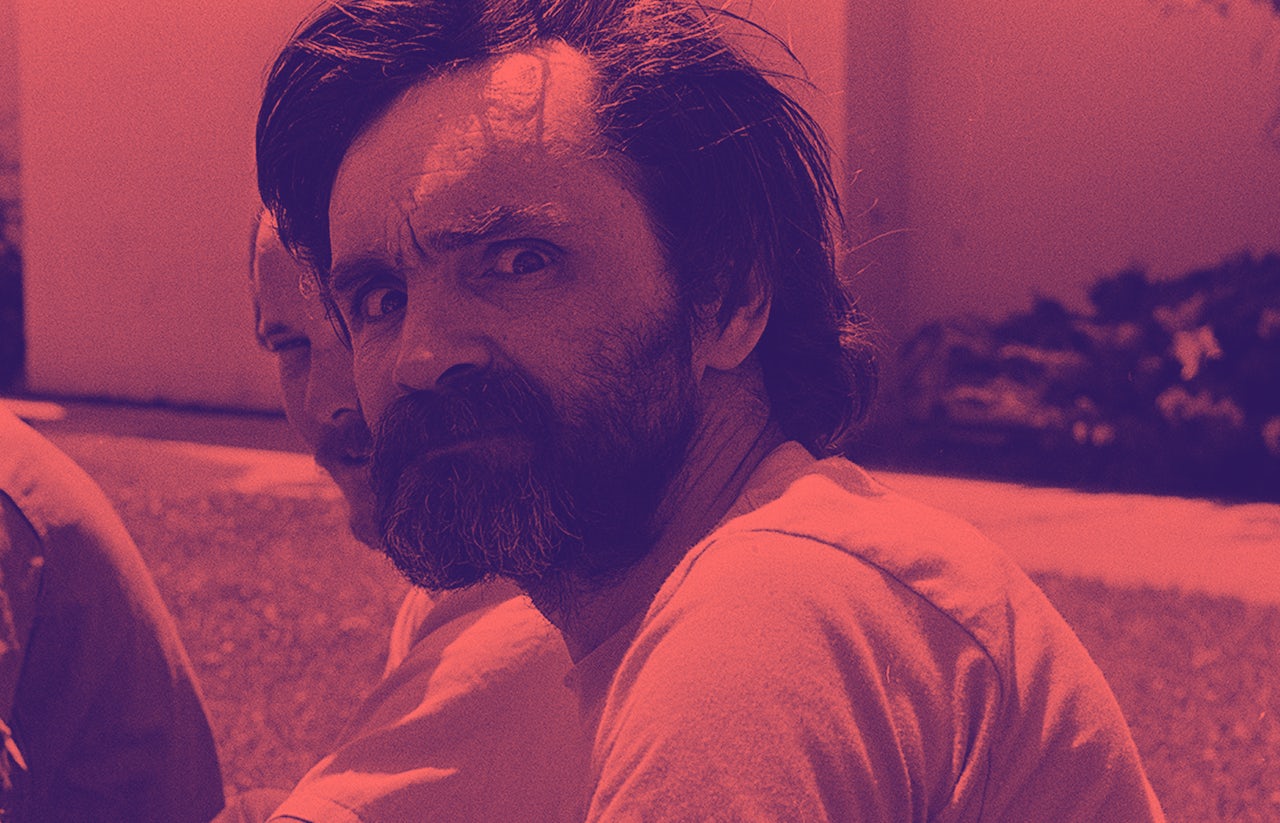“Charles Manson stole this song from the Beatles, now we’re stealin' it back.”
Bono offers this rallying cry at the beginning of U2’s 1988 cover of “Helter Skelter,” the 1968 Beatles song Charles Manson co-opted as a call to arms to start a race war or, failing that, a slaughter of innocents in the Hollywood Hills. The Manson-instigated murders of actress Sharon Tate, Jay Sebring, Abigail Folger, Wojciech Frykowski, and Steven Parent — and Leno and Rosemary LaBianca, who were killed a night later — caused seismic waves in American culture, a fact made plain by Bono’s proclamation on Rattle & Hum two decades after the crimes. Just this month, before Manson finally died at the age of 83, Quentin Tarantino sealed a deal to direct a film utilizing the Manson Family murders as a backdrop.
Death came too slowly for Charles Manson. By sticking around for nearly a half-century after his 1971 conviction for murder, he had the opportunity to write his legacy, to parlay his status as America’s most famous critic into the rock star he always yearned to be.
The fact that Manson’s cult grew while he was incarcerated was no accident. It had its origins in Lie: The Love And Terror Cult, a cheapo exploitation LP released by Phil Kaufman in 1970 while Manson sat in jail, waiting to be tried for the Tate-LaBianca crimes. The two had met in prison in the mid-’60s, a meet-cute that suggests that neither party belonged on the forefront of the counterculture. Both were barnacles, hanging onto whales. Kaufman wormed his way into the inner circles of the Rolling Stones, using this as a launchpad to tour manage the Flying Burrito Brothers, during which time he’d befriend its leader Gram Parsons, whose corpse he’d later steal and illegally burn in Joshua Tree National Park. Manson wooed Dennis Wilson, who would usher him into the inner circles of the Beach Boys, introducing him to a bunch of Southern Californian hippie high rollers, including Neil Young — who vouched for Charlie to the powerful Warner record executive Mo Ostin — and Terry Melcher, the record producer who originally rented the home at 10050 Cielo Drive that became the site for the Tate murders.
Puffed up by his friendship with Dennis Wilson, Manson expected Melcher would sign him for a record deal. Since he was no fool, Melcher recognized that Manson was at best a musical mediocrity, a guy who could maybe string together a dippy melody but usually would just strum in hopes that he’d conjure a song. Zonked out on many substances of his choice and perhaps a bit intimidated by Charlie’s intensity, Wilson advocated for Manson within the Beach Boys, coercing them to record his “Cease to Exist” as “Never Learn Not to Love.”
“Never Learn Not to Love” wound up on the second side of the Beach Boys’ February 1969 album 20/20. It also showed up as the flipside of “Bluebirds Over The Mountain,” a single that couldn’t crack the Top 60, let alone the Top 40. Nevertheless, the very fact that the Beach Boys cut a Manson song suggested that there was something of merit within his songwriting, a notion that is rank nonsense but persisted for years and years, encouraging a cult that disavowed the murder but loved the murderer.
Available as a private press LP and bootlegs, Lie wasn’t an easy album to find in the ’70s and ’80s. You had to know somebody who knew somebody in order to hear it, so you’d inevitably arrive to it with a certain sense of anticipation: If it took this much effort to hear it, surely it must have some merit. This willful delusion crept into the underground of the ’80s, where flirtations with Manson were accepted, if not encouraged. Enthusiasts of pop culture detritus Redd Kross covered “Cease to Exist” in 1982, opening the door for a flood of Manson-inspired punk. Henry Rollins thought it was a wise thing to produce a new Manson album for SST in 1984, a project that was scrapped but was a sign of how the underground continued to harbor a Mason fascination. Degenerate punker GG Allin covered Charlie’s “Garbage Dump” in 1987, old Manson Family recordings saw the light of day on indie LPs and cassettes, and Sonic Youth flirted with the Tate-LiBianca mythology on “Death Valley 69.”
Cumulatively, all these records kept Manson as a presence in rock & roll, albeit an elusive one. He was unavoidable, but you had to be tuned into the frequency to discern his location. In the ’90s, Manson references finally became too on the nose. Marilyn Manson adopted his surname for his shock-rock; Guns N Roses cut Charlie’s “Look at Your Game, Girl” for their 1994 covers album The Spaghetti Incident?; Trent Reznor decided to rent 10050 Cielo Drive so he could record The Downward Spiral there. Paying respects to Manson was now enshrined as a way of establishing your edge, an idea that certainly inspired that brief, horrible moment when the paintings of serial killers were considered as “outsider art.”
The canvases of John Wayne Gacy don’t garner much attention now, because they’re foremost illustrations of his banality. Now that he’s gone, many years after he should’ve passed, the music of Charles Manson should be equally dismissed. There's no denying that Manson was a powerful, influential figure of the 20th Century, helping to create the lurid, celebrity-obsessed world we call our own. He’s inspired rich, complex art and will continue to do so — it's hard not to think that Tarantino’s film may burrow into the essential paranoid truths of the era — but Charles Manson was not an artist. He was a psychopath and a criminal, and now that he’s dead nobody should ever pretend that his music was ever worth consideration.
